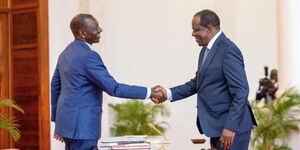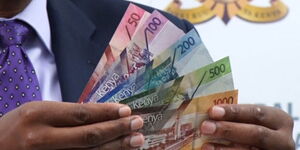Hardly a week after economists and financial experts predicted that the Kenyan Shilling would fall further against the US Dollar, the local currency on Monday, May 20, weakened further against the greenback.
In a report published by Reuters, analysts attributed the weakening of the Kenyan Shilling to a high demand for the Dollar by commercial banks.
The experts further detailed that the Shilling edged lower against the Dollar as a result of foreign exchange pressures caused by fuel retailers and manufacturers seeking the US currency.
As of Monday, May 20, commercial banks quoted the shilling at 131.50/132.50 per dollar, compared to 130.00/131.00 at the end of the Friday, May 17, session.
Fuel retailers and manufacturers who sought to trade on the international front were hit by a Dollar shortage thus forcing them to seek it at higher rates.
A resurgence of the Dollar against major world currencies was also attributed to the weakening of the Shilling which was in mid-March this year ranked as the best-performing currency globally.
On Thursday, May 16, analysts predicted that the Shilling would weaken as fuel companies continued to demand more Dollars to purchase petroleum from oil-rich countries.
“Kenya's shilling was stable on Thursday, but it could weaken in coming days due to demand from fuel retailing companies,” noted the analysts.
At the time of their prediction, the Shilling was trading at 130.00/131.00 per dollar as quoted by commercial banks.
There were fears that a weaker Shilling could mean a return to costlier debt servicing and expensive purchases by importers.
The Central Bank of Kenya (CBK) in April revealed that Kenya's debt had been reduced by Ksh1 trillion from Ksh11 trillion due to sudden gains that were made by the Kenyan currency.
In the same month (April), a report by the World Bank ranked the Shilling as the best-performing currency in Sub-Saharan Africa.
The report by the multilateral lender attributed the performance to several monetary policies implemented by Kenya's Central Bank which included hiking the base lending rate.
"The Kenyan Shilling is the best-performing currency in the subcontinent as it recorded an appreciation of 16 percent so far this year. After strengthening by 14 percent by mid-February, the Zambian Kwacha has lost some ground and recorded a year-to-date appreciation of 2.4 percent as of mid-March," the World Bank noted in its report.
Concurring with the CBK, a report published by the World Bank also attributed Shilling's three-month gain to the government's decision to repay part of the Ksh310 billion Eurobond acquired by the Kenyan government in 2014.
Increased diaspora remittances and a hike in coffee and tea exports were also cited as factors behind Shilling's stabilisation against the Dollar.
Oversubscription of infrastructure bonds by foreign investors was also mentioned as a major contributor to the Shilling's stability.












